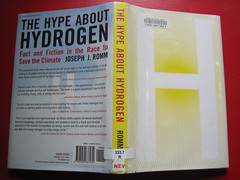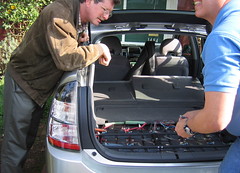Hydrogen Highway
Meanwhile, as other more sane countries work to increase their renewable energy generation, we in Bushanegger Land want the Hydrogen Highway. We are going to be the first on the planet to drive the fuel cell car in large numbers. It will knock the socks off of all those foreign hybrids.
While the Sparrow was down, I started to read about hydrogen technology, so I would be prepared to shoot down this boondoggle. And shoot it down we must, at least for transportation purposes. Governor Schwarzenegger is right now asking for $54 million to implement the Hydrogen Highway. Money to build 100 hydrogen fueling stations as an incentive to automakers to build fuel cell cars. "Build it and they will come" say its supporters as if waiting for heroes from another dimension. And while automakers hide behind the "R & D" smokescreen for the 15-20 years that it will take to make a viable fuel cell car, they continue to resist building high mileage, low emission cars now.
We are being sold on hydrogen as the ultimate Green energy fuel because it can be made, not only from natural gas, but from water with electricity from renewable resources and since fuel cell cars produce no emissions at all, it is a veritable Green wet dream. Or is it?
Consider this "To replace all the gasoline sold in the U.S. today with hydrogen from electrolysis would require more electricity than is sold in the U.S. today."
And that's just to make the hydrogen. It also takes energy to keep hydrogen in pressurized tanks and to transport it. Hydrogen is not as dense as gasoline. One tanker filled with gasoline can fuel 800 cars. An equivalent size canister of hydrogen will only fuel 80 cars. Think of all the diesel trucks that will be needed to transport the stuff. I know I don't want to see so many more trucks on the road.
And if people are not swayed by the economics there's always the safety factor. Remember that e-mail many of you received/sent warning women that they were more likely to start fires in gasoline stations because they were in the habit of getting back in the car after putting the nozzle in the tank? It turns out that was a hoax because the static electricity generated by sliding across the seat is not nearly enough to ignite gasoline - but it is enough to ignite hydrogen. Ditto for cell phone use.
And this is the one that got me. Once the hydrogen is ignited, the flames are almost invisible. To find the fire you have to walk holding a piece of paper in front of you and watch to see when it burns.
And here's another interesting property of hydrogen - when it reacts with metal it makes it brittle. So brittle pipelines, brittle car parts, brittle containers. Not to mention that hydrogen is the leakiest of gases.
You can download the California Hydrogen Highway Blueprint. It mentions nothing about hydrogen safety issues, but implies that regulations will have to be softened to encourage the plan. It also assumes that hydrogen will be made from renewable energy, but admits that if it were made from our current electric grid, emissions would be more than for a gas car.
An electric car uses one-fourth the electricity that it takes to make enough hydrogen to go the same distance. So are we EVers set to sell everyone on electric cars? No, not really considering the limitations only a highly motivated EVer could love (until the lithium battery is affordable). We want electric cars yes, but America wants options. The option to drive as far as the eye can see across this great nation of ours.
The solution? The plug-in hybrid. An extra battery pack on the hybrid, which you plug in at home (but only if you want to), would give you the option of using the car in electric only, stealth mode while driving around town. This is possible if you're going 30 miles an hour or less. When you hit the freeway the computer starts the internal combustion engine automatically. With the plug-in option a gas optional vehicle, as these are being called, could easily get 100 miles per gallon since so much of our driving is around town anyway. Flexible fuel technology using cellulosic ehtanol (made from plant wastes), coupled with the battery pack brings the potential mpg to 500.
No sooner was this concept coming to light than Toyota started advertising their Prius as the electric car you don't have to plug-in. Whether to subvert Prius Plus efforts or because people still think electric means you have to plug it in, we don't know, but there is something about plugging in a car that just gets that big "deal breaker" sign flashing in people's heads. What is it about plugging in your car? Does the cord coming out of a car remind you of the string on a tampon? Is it a social taboo or just auto-advertising conditioning?
No sir, we do not plug in our cars. We are not homemaker sissies. We do not drive appliances. Or as one of my clients pointed out - the car doesn't stay plugged in, which means you have to manage to remember to plug it in. And that's one more blinkin' thing on your to-do list. Okay yes, I did forget to plug in my car one night because I was waiting until 6 p.m. for off peak hours to begin. And I was so mad the next morning because I couldn't drive it; didn't even have time for a fast 220 volt/2hr charge because I didn't remember until I was ready to leave.
The plug-in hybrid technology will give you the best of both worlds. It's time to fight the anti-plug-in conditioning. Repeat after me. "Yes the Prius is wonderful, but it would be even better if I had the option to plug it in." Just say no to hydrogen. Say yes to a "gas optional" incentive program and show those automakers what we want. This is what Austin, Texas (where 6% of their power is wind generated) is doing with its $1,000 rebates offered to the first 1,000 Austin buyers of plug-in vehicles.
Meanwhile I've been riding my bike a lot lately and feeling very fit.






4 Comments:
Jeez Louise, looks like you have to be rich to be driving eco-friendly.. when will things change?
Yes driving green is expensive especially in the U.S. with all the crash tests required and other regulations that make it hard for small car companies to get a toe hold in the U.S. Other countries are making strides. This Korean EV is actually cheap for a lithium battery powered car. Check it out at http://www.greencarcongress.com/2005/05/new_korean_ev_m.html. Thanks to Odograph for showing me this site.
Oops, the address was cut off. It's
www.greencarcongress.com/2005/05/
new_korean_ev_m.html
Given the fact that Toyota has 2 secret plug in Prius prototypes what someone on the Prius+ Group archives said begins to makes sense:
I too would be very interested in whether the Prius uses analogous batteries to the RAV4-EV; I have heard that Panasonic (Matsushita) was enjoined to stop making RAV4-EV batteries by the Chevron-Texaco lawsuit, so I suppose that the batteries they are allowed to make cannot be adapted to the RAV4-EV or any other existing EV, part of their campaign to discredit and kill EVs. The question is, would they be allowed to sell NiMH Prius batteries for a car maker who wishes to make a hybrid that is capable of being plugged in? It seems not, and there may be a clause in the settlement somewhere that required Toyota to make it difficult to plug in their Prius. It would have been simple for Toyota to build racks for an expanded battery, to make the second motor capable of driving it at freeway speeds, and put a battery charger on the pack. The fact that they, and every other maker, sabotaged would-be pluggable hybrids tells me that the lawsuit might have been effective, with Chevron-Texaco in control of the NiMH patents
Post a Comment
<< Home